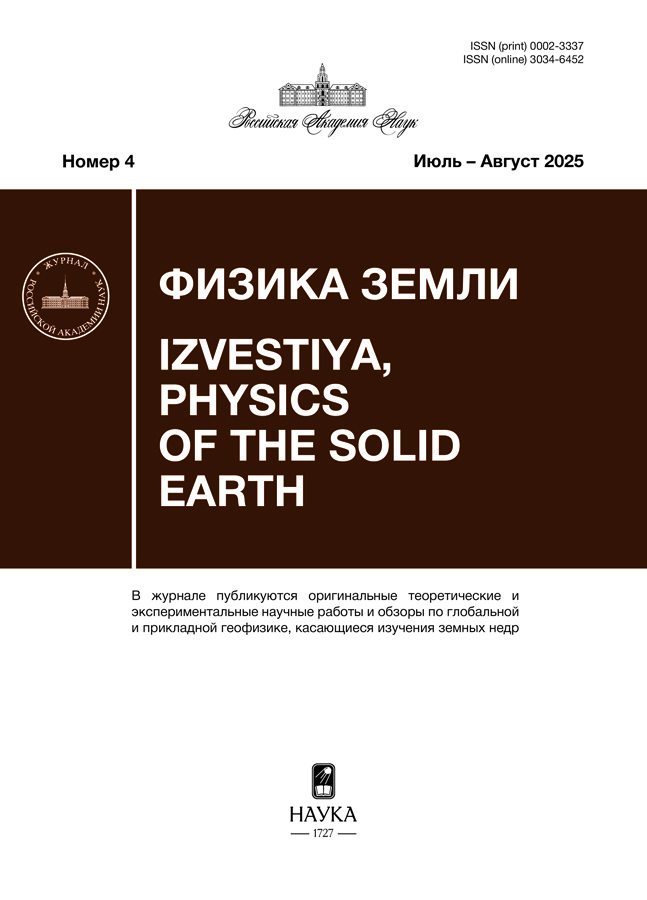Systematic earthquake forecast
- 作者: Gitis V.G.1, Derendyaev A.B.1
-
隶属关系:
- Kharkevich Institute for Information Transmission Problems RAS
- 期: 编号 4 (2025)
- 页面: 35-49
- 栏目: Articles
- URL: https://journals.eco-vector.com/0002-3337/article/view/692417
- DOI: https://doi.org/10.31857/S0002333725040036
- ID: 692417
如何引用文章
详细
A computer-based method for systematic earthquake forecasting is discussed. The forecast is calculated regularly and over a fixed time interval. The result is a map of the alarm zone where the epicenters of target earthquakes are expected. A forecast is considered successful if all the epicenters of target earthquakes within the given interval fall into the alarm zone. The minimum alarm area method is used to train the forecast. The method optimizes the probability of a successful forecast with a limited alarm zone. This method also estimates the probability of success for the next forecast interval and explains the alarm zone using logical implication and a list of previous earthquakes with similar precursor values. An example of systematic forecast of Kamchatka earthquakes is presented.
作者简介
V. Gitis
Kharkevich Institute for Information Transmission Problems RAS
Email: gitis@iitp.ru
Moscow, Russia
A. Derendyaev
Kharkevich Institute for Information Transmission Problems RAS
Email: wintsa@gmail.com
Moscow, Russia
参考
- Завьялов А.Д. Среднесрочный прогноз землетрясений: основы, методика, реализация. М.: Наука. 2006.
- Мячкин В.И., Костров Б.В., Соболев Г.А., Шамина О.Г. Основы физики очага и предвестники землетрясений. Физика очага землетрясения. М.: Наука. 1975. С. 6–29.
- Соболев Г.А. Основы прогноза землетрясений. Общество с ограниченной ответственностью Международная академическая издательская компания “Наука/Интерпериодика”. 1993.
- Соболев Г.А. Модель лавинно-неустойчивого трещинообразования-ЛНТ // Физика Земли. 2019. № 1. С. 166–179.
- Соболев Г.А., Закржевская Н.А., Акатова К.Н., Гитис В.Г., Дерендяев А.Б., Брагин В.Д., Сычева Н., Кузиков С.И. Динамика взаимодействия полей сейсмичности и деформаций земной поверхности (Бишкекский геодинамический полигон) // Физика Земли. 2010. № 10. С. 15–37.
- Соболев Г.А., Пономарев А.В. Физика землетрясений и предвестники. Общество с ограниченной ответственностью Международная академическая издательская компания “Наука/Интерпериодика”. 2003.
- Соболев Г.А., Тюпкин Ю.С. Аномалии в режиме слабой сейсмичности перед сильными землетрясениями Камчатки // Вулканология и сейсмология. 1996. № 4. С. 64–74.
- Соболев Г.А., Тюпкин Ю.С. Стадии подготовки, сейсмологические предвестники и прогноз землетрясений Камчатки // Вулканология и сейсмология. 1998. № 6. С. 17–26.
- Чебров, Д.В., Тихонов, С.А., Дрознин, Д.В., Дрознина, С.Я., Матвеенко, Е.А., Митюшкина, С.В., Ящук, В.В. Система сейсмического мониторинга и прогнозирования на Камчатке и ее развитие. Основные результаты наблюдений в 2016–2020 гг. // Российский сейсмологический журнал. 2021. № 3 (3). С. 28–49.
- Corbi F., Sandri L., Bedford J., Funiciello F., Brizzi S., Rosenau M., Lallemand S. Machine learning can predict the timing and size of analog earthquakes // Geophys. Res. Lett. 2019. V. 46 (3). P. 1303–1311.
- Gitis V., Derendyaev A., Petrov K. Analyzing the performance of GPS data for earthquake prediction // Remote Sensing. 2021. V. 13. № 9. P. 1842.
- Gitis V., Derendyaev A. A Technology for Seismogenic Process Monitoring and Systematic Earthquake Forecasting // Remote Sensing. 2023. V. 15. № 8. P. 2171.
- Gitis V. G., Derendyaev A. B. Optimization of the Approach to Systematic Earthquake Forecasting // Journal of Communications Technology and Electronics. 2024. P. 1–23.
- Gitis V.G., Derendyaev A.B., Pirogov S.A., Spokoiny V.G., Yurkov E.F. Adaptive Estimation of Seismic Parameter Fields from Earthquake Catalogs // Journal of Communications Technology and Electronics. 2015. V. 60. № 12. P. 1459–1465.
- Gitis V.G., Derendyaev A.B., Pirogov S.A., Spokoiny V.G., Yurkov E.F. Earthquake prediction using the fields estimated by an adaptive algorithm. Proceedings of the 7th International Conference on Web Intelligence, Mining and Semantics. 2017. P. 1–8.
- Kagan Y.Y. Earthquakes: models, statistics, testable forecasts. John Wiley & Sons. 2013.
- Kail R., Burnaev E., Zaytsev A. Recurrent convolutional neural networks help to predict location of earthquakes // IEEE Geosci. & Remote Sens. Lett. 2021. V. 19. P. 1–5.
- Kanamori H., Brodsky E.E. The physics of earthquakes // Reports on progress in physics. 2004. V. 67. № 8. P. 1429.
- Kossobokov V., Shebalin P. Earthquake Prediction in Nonlinear Dynamics of the Lithosphere and Earthquake Prediction. Berlin: Springer-Verlag. 2003.
- Kullback S. Information Theory and Statistics. New York: Wiley. 1958.
- Mignan A., Broccardo M. Neural network applications in earthquake prediction (1994–2019): Metaanalitic and statistical insights on their limitations // Seismolog. Res. Lett. 2020. V. 91 (4). P. 2330–2342.
- Panakkat A., Adeli H. Neural network models for earthquake magnitude prediction using multiple seismicity indicators // Int. J. Neural Syst. 2007. V. 17. P. 13–33.
- Polzehl J., Spokoiny V.G. Adaptive weights smoothing with applications to image restoration // Journal of the Royal Statistical Society: Series B (Statistical Methodology). 2000. V. 62 (2). P. 335–354.
- Polzehl J., Spokoiny V. Propagation-separation approach for local likelihood estimation // Probability Theory and Related Fields. 2006. V. 135 (3). P. 335–362.
- Rhoades D.A. Mixture models for improved earthquake forecasting with short-to-medium time horizons // Bull. Seismolog. Soc. Am. 2013. V. 103 (4). P. 2203–2215.
- Shebalin P. N., Narteau C., Zechar J. D., Holschneider M. Combining earthquake forecasts using differential probability gains // Earth, Planets and Space. 2014. V. 66. P. 1–4.
补充文件








